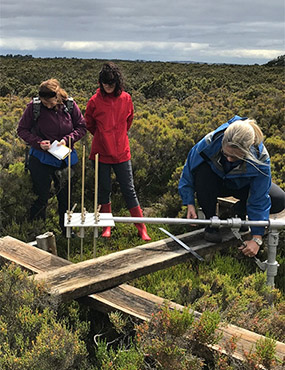Coastal wetlands help to prevent global warming
Our research has demonstrated that coastal wetlands substantially increase their carbon sequestration as sea levels rise, providing a counterbalance to global warming.

Blue carbon horizons
Working with multiple levels of government, our research has translated into protection and restoration of these important coastal ecosystems.
The research was awarded the Eureka Prize for Environmental Research in 2019.
Research associated with impact
Our analysis of carbon stored in 345 saltmarsh settings across six continents (Rogers et al. 2019) showed that coastlines subject to gradual sea-level rise over the past few thousand years (North America, Europe) had, on average, 2-4 times more carbon in the surface 20 cm of sediment, and 5-9 times more carbon in the lower 50-100 cm of sediment, compared to saltmarshes on coastlines with a long period of stable sea-level (Australia, South Africa, South America and China).
On coastlines where sea level has been rising most rapidly, organic carbon is more efficiently buried as the wetland accretes and is stored safely below the surface.
On coastlines where sea level has been stable or falling, less organic carbon is preserved. However, with higher rates of sea-level rise forecast, these latter coastlines may be the sleeping giants of global carbon sequestration, with sea-level rise triggering an increase in carbon accumulation.
Macquarie University NSW 2109
Professor Neil Saintilan
Macquarie University
Dr Jeff Kelleway
University of Wollongong
Associate Professor Kerrylee Rogers
University of Wollongong
Professor Colin Woodroffe
University of Wollongong
Dr Atun Zawadzki
ANSTO - Australia's Nuclear Science and Technology Organisation
Dr Debashish Mazumder
ANSTO - Australia's Nuclear Science and Technology Organisation
Professor Patrick Megonigal
Smithsonian Environmental Research Centre
Professor Janine Adams
Nelson Mandela University, South Africa
The potential benefit of wetlands in combating climate change is compromised by ongoing clearance and reclamation.
We have advocated strongly for the inclusion of mangrove and saltmarsh restoration in emission reduction programs and, in collaboration with colleagues across the globe, achieved considerable success, as evidenced by recent initiatives such as the International Partnership for Blue Carbon.
At the national level, the Commonwealth Government has accepted our recommendations that coastal wetland restoration be pursued as a climate change mitigation strategy and are moving to a scoping phase under the Emissions Reduction Fund.
The stable coastlines of Africa, Australia, China and South America have been subject to unchanging or falling sea levels over the past few millennia. Collectively, these coastlines contain half of the global mangrove and saltmarsh extent.
These relatively old wetlands by global standards have been exposed high in the intertidal zone for centuries, making them vulnerable to oxidation and loss of carbon over time, and show lower levels of carbon than North American and European coastal wetlands.
Our research demonstrates that rather than being poor cousins in their carbon contribution, Southern Hemisphere wetlands have the potential to sequester an additional 5 million tonnes of atmospheric carbon per year if the rate of sea-level rise were to double.
At the same time, this acceleration in carbon sequestration is also a strategy that helps the wetlands adjust to sea-level rise. The value of wetland preservation and restoration in the Southern Hemisphere should not be based on existing levels of carbon, but their potential for accelerating carbon sequestration over the coming century.
- Rogers K., Kelleway J., Saintilan N., Megonigal P.,Adams J., Holmquist JR, Meng L.,Schille-Beers L., Zawadski A., Mazumder D., and Woodroffe C. (2019). Wetland carbon storage controlled by millennial-scale variation in relative sea-level rise. Nature 567: 91-95.
Blue Carbon Horizons team
Winner of the 2019 Eureka Prize for Environmental Research